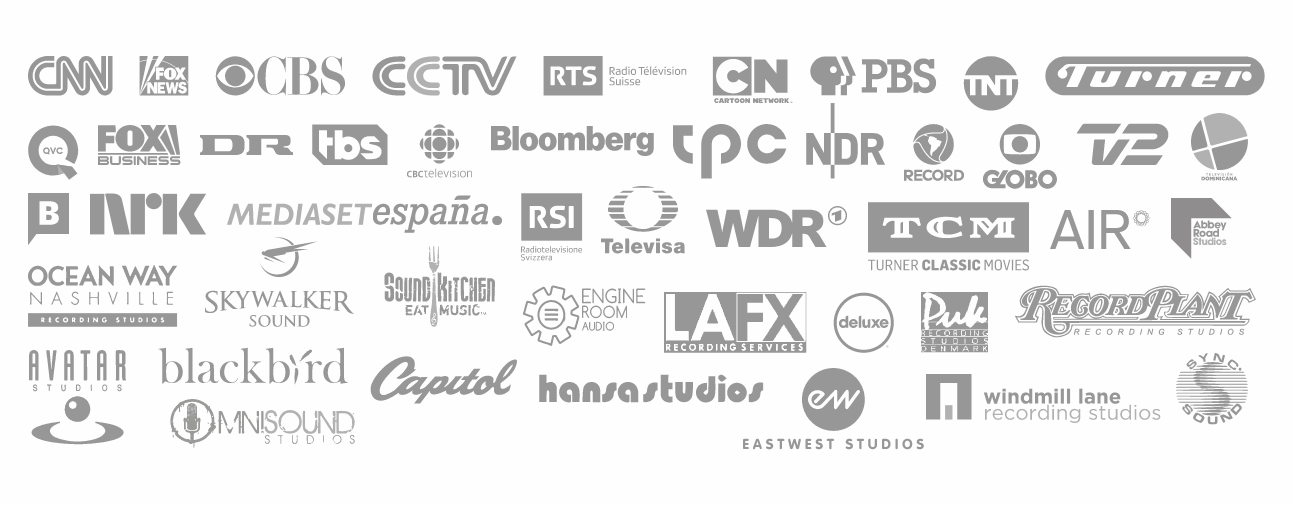Loudness Literature and Glossary
Loudness Literature and Glossary
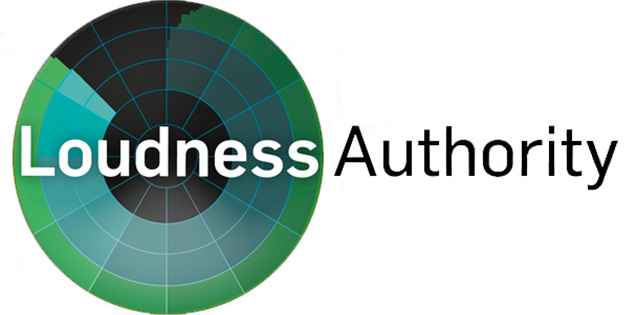
Our CTO for Broadcast & Production, Thomas Lund, has taken a number of mobile devices, including Apple's iPhone and iPad, to the test bench at the 'TC Lab'.
In this white paper, all the test results, recommendations and a practical guide are disclosed.
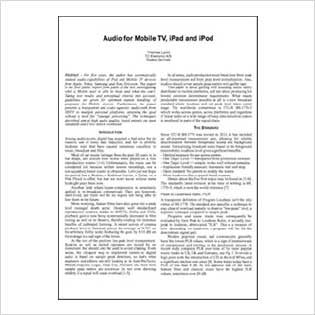
By Thomas Lund
For five years, the author has systematically studied audio capabilities of Pod and Mobile TV devices from Apple, Nokia, Samsung and Sony Ericsson. This paper is the first public report from parts of the test investigating what a Mobile user is able to hear, and what she can't.
Published at NAB 2013, Las Vegas.
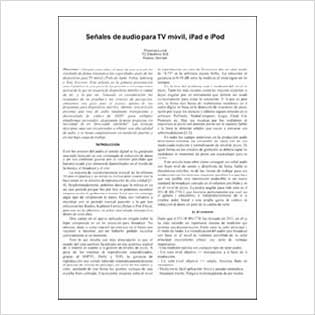
By Thomas Lund
Durante cinco años, el autor de este artículo ha estudiado de forma sistemática las capacidades audio de los dispositivos para TV móvil y Pods de Apple, Nokia, Samsung y Sony Ericsson. Este artículo es la primera presentación ante del público de una parte de las pruebas e investigaciones acerca de lo que un usuario de dispositivos móviles es capaz de oír, y lo que no.
Publicado en NAB 2013, Las Vegas
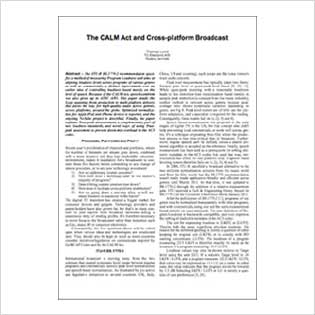
By Thomas Lund
This paper details the loop spanning from production to multi-platform delivery that paves the way for high-quality audio across genres and platforms. Optimized normalization for iPod and iPhone devices is reported, and the ongoing NoTube project is described.
Published at NAB 2012, Las Vegas.
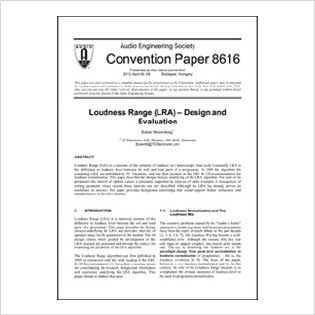
By Esben Skovenborg
In 2009 we published the algorithm for computing LRA that was included in the EBU R-128 recommendation for loudness normalisation. This paper describes the design choices underlying of the LRA algorithm.
Published at AES 2012, Budapest.
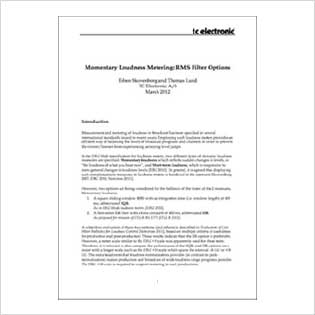
By Esben Skovenborg & Thomas Lund
Employing loudness meters provides an efficient way of balancing the levels of broadcast programs and channels in order to prevent the viewer/listener from experiencing annoying level jumps.
Published March 2012.
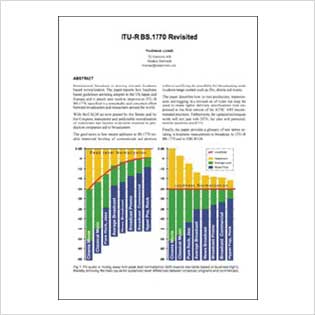
By Thomas Lund
The ITU standard has been updated to BS.1770-2. It now work across genres, for instance between commercials and regular programming. Transparency is a must for the broadcaster, for the producer, and wrt legislation such as the CALM Act. Coherent new EBU R128 tools are also described.
Published at NAB 2011, Las Vegas.
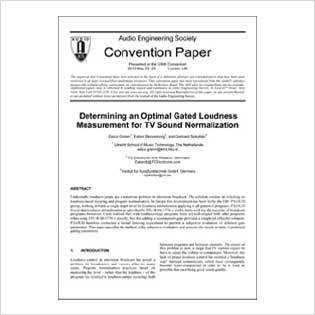
By Grimm, Skovenborg & Spikofski
Loudness normalization as specified by ITU-R BS.1770-1 works fairly well for most broadcast programs. However, wide loudness-range programs may not be well-aligned with other programs. Adding a measurement gate provides a simple yet effective solution.
Published at AES 2010, London.

By Esben Skovenborg & Thomas Lund
EBU P/LOUD devoted much time to finding a transparent cross-genre measure for program normalization. This paper was part of that process. It also describes Loudness Range, examines the listener's loudness jump tolerance, and presents the Zap test.
Published at AES 2009, New York.

By Esben Skovenborg & Thomas Lund
The paper presents two descriptors, "Center of Gravity" and "Consistency", to summarize the loudness properties of film, music and broadcast programs and tracks. Applications include delivery specifications, diagnostics, logging and metadata delivery, for instance for use with MPEG and AC3 codecs.
Published at AES 2008, San Francisco.
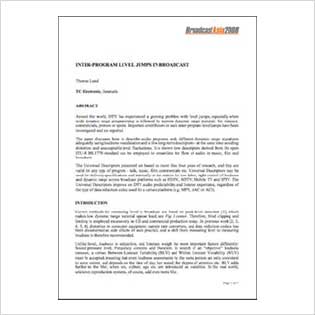
By Thomas Lund
DTV experiences a growing problem with level jumps between programs; especially when wide dynamic range programming is followed by commercials, promos or sports. Important contributors to such inter-program level jumps have been investigated and are reported.
Published at Broadcast Asia 2008, Singapore.
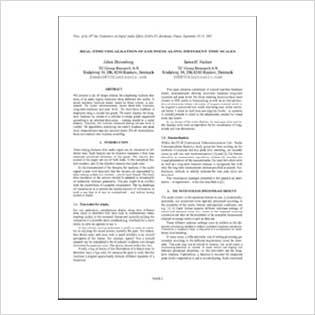
By Esben Skovenborg & Søren H. Nielsen
A novel real-time loudness meter is presented, which simultaneously shows short-term loudness, long-term loudness and peak level.
Published at DAFx 2007, Bordeaux.
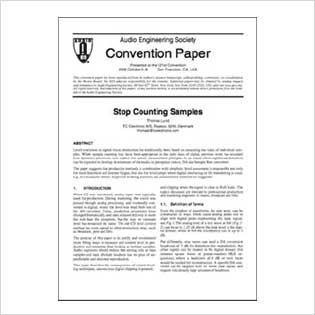
By Thomas Lund
Report from the frontline of the CD Loudness war, 2006: It's not over yet. Read about distortion developing in CD players, data reduction systems etc. The Appendix suggests improved procedures to follow in production and mastering.
Published at AES 2006, San Francisco.
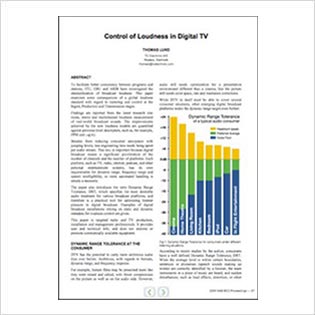
By Thomas Lund
Paper describing various loudness measurement models and their limitations. Consumer Dynamic Range Tolerance (DRT) is quantified, and station infrastructure taking DRT into account is presented.
Published at NAB 2006, Las Vegas.
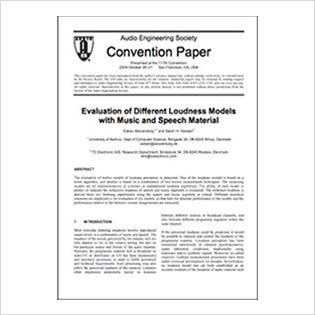
By Esben Skovenborg & Søren H. Nielsen
The ability of twelve loudness models to measure speech and music segments is evaluated. Leq(A) and Leq(M) are among the worst performers, while Leq(RLB) from an ITU experiment, and new advanced models, correlate better with extensive listening tests.
Published at AES 2004, San Francisco.
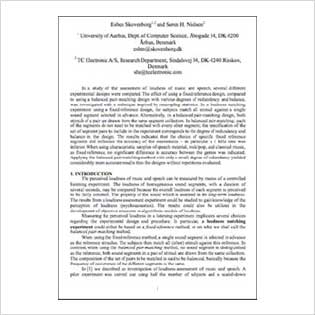
By Esben Skovenborg & Søren H. Nielsen
Different loudness experimental designs are compared, and the effect of using a fixed-reference is evaluated against a balanced pair-matching design.
Published at SOAS 2004, Poznan.
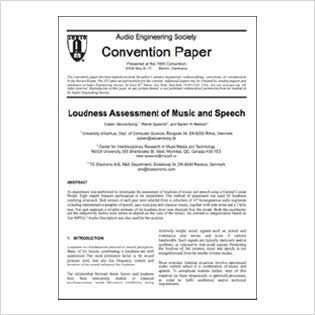
By Esben Skovenborg, Rene Qesnel & Søren H. Nielsen
An experiment was performed to investigate the assessment of loudness of music and speech using a General Linear Model.
Published at AES 2004, Berlin.
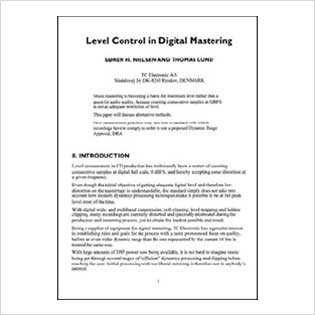
By Søren H. Nielsen & Thomas Lund
Music mastering is becoming a battle for maximum level rather than a quest for audio quality, because counting consecutive samples at OdBFS is not an adequate restriction of level.
Published at AES 1999, New York.
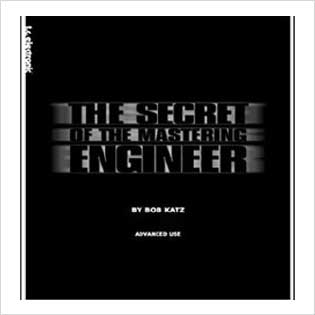
By Bob Katz
Mastering is an art and a science. In this acclaimed booklet, Bob Katz shares good advice about monitoring, metering and processing. About listening to the music and supporting it as the road to Nirvana - from one of the true yogis of our industry.
Published at SOAS 2004, Poznan.
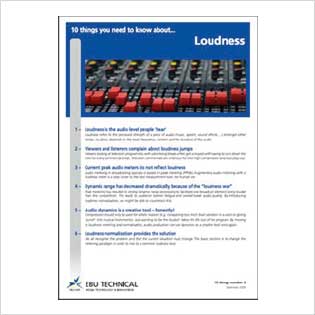
EBU provides a brief overview of 10 basic topics you need to know about loudness. Not in detail, but you will get a good starting point to build on.
Recommended practices for Digital Television in the US. A/85 is rooted in BS.1770 Loudness and True-peak level. It specifies an anchor based or a universal approach to audio normalization without a clear distinction of when to use what. A/85 includes extensive information about calibrated monitoring environments and may function somewhat like a Dolby manual. Unlike EBU R128, A/85 is only focused on the digital television platform and on the AC3 codec. Published Nov. 2009.
A perceptual property of sound. Humans rate loudness between quiet and loud. Several physical and psychological factors contribute to the sensation of loudness. An example of a listening experiment to investigate this property is described in Skovenborg, Quesnell & Nielsen, "Loudness Assessment of Music and Speech", AES 116 convention paper. Note: Loudness does not refer to the switch on a hi-fi which changes the frequency response as the gain ("volume" control) of the system is varied.
See ITU-R BS.1770
A standardized measure of a the loudness range of a program or a music track. Loudness Range, abbreviated LRA, is based on BS.1770 and part of EBU R128. Loudness Range is measured in units of LU and basically measures the distance between soft and loud parts of the program. The measure is used as a production guideline, for QC manually or on a server, and for checking the integrity of an entire signal-path. The number stays the same downstream of production, even if a program is normalized. Note: Loudness Range replaces a TC Electronic descriptor, "Consistency", used in first generation of its LM5 meters.
Studio speakers may be calibrated to produce a specific SPL at a specific location in a specific room. Calibrated monitoring is of benefit to the production of quality audio, and makes moving of a project between studios less complicated. Calibrated monitoring is an advantage to keep loudness under control by ear (as well as by loudness meter), but also to achieve a consistent spectral balance from program to program. When monitoring level is undefined, the level-dependent sensitivity of our ears is allowed to play a role in mixing. With broadcast loudness now standardized, the time is perfect to encourage calibrated monitoring widely. ATSC A/85 includes a discerning chapter about this issue.
Abbreviation of Loudness Range.
Studio speakers may be calibrated to produce a specific SPL at a specific location in a specific room. Calibrated monitoring is of benefit to the production of quality audio, and makes moving of a project between studios less complicated. Calibrated monitoring is an advantage to keep loudness under control by ear (as well as by loudness meter), but also to achieve a consistent spectral balance from program to program. When monitoring level is undefined, the level-dependent sensitivity of our ears is allowed to play a role in mixing. With broadcast loudness now standardized, the time is perfect to encourage calibrated monitoring widely. ATSC A/85 includes a discerning chapter about this issue.
The unit of loudness on a relative scale. 1 LU is equivalent to 1 dB. It may also be used to measure Program Loudness, if a Target Level has been defined a zero point on the LUFS scale, for instance 0 LU = -23 LUFS.
Communations Research Centre. Federal R&D facility in Canada and driving force behind the studies and listening experiments underlying ITU-R BS.1770.
The unit of loudness level of a digital signal on an absolute scale. 1 LUFS is equivalent to 1 dB. Most levels in broadcast are in the -36 to -18 LUFS range, while level closer to 0 LUFS would signify very loud.
A combined structure consisting of an encoder and a decoder. Data-reduction systems sucs as AAC, MP3, and AC3 are examples of audo codecs.
The Maximum loudness level measured when a sliding window is applied from the beginning to the end of a program. In EBU R128, the width of the sliding window is defined at 400 ms or 3 sec. Max Loudness may be used as a second line of defense against annoyingly loud commercials, should producers start dodging the average approach to loudness that comes with EBU Program Loudness normalization.
The abbreviation of decibel. The dB is employed to express a logarithmic ratio between, for instance, two amplitude levels. In this case, a ratio of 10:1 is the same as 20 dB while 1:10 = 10% is -20 dB. Thereby, dB by nature is always relative. There is no such thing as a level of +3 dB, while a gain of +3 dB is applicable. Sometimes the relative nature of dB is implied, for instance if sound pressure level (SPL) is expressed merely in "dB". Since hearing is a logarithmic sense, gain, distortion, signal/noise and other relationships in audio are typically expressed in dB rather than in percent.
Extra data about core data. Core data could be the actual audio, video or text content while metadata may hold the tools necessary to access or understand core data. Metadata is widely used to lock out other vendors from dealing with core data, for instance in word processing, and should therefore only be embraced when based on open standards. The AES/EBU audio interface includes open standard metadata, while AC3 contains certain Dolby specific metadata. In such cases, one goal is to minimize dependency of these elusive extra data.
An absolute unit used to describe the sample level in the digital domain. 0 dBFS, where "FS" stands for Full Scale, denotes the maximum encoding value for a sample. Measurements of level specified in dBFS typically indicate sample peak level or true peak level.
The measurement of loudness using a 400 ms sliding window, defined in EBU R128. Momentary loudness should be available for real-time display of loudness on EBU Mode meters. Momentary Loudness yields the fastest and most dynamic display of loudness level.
Refers to dBFS true-peak level
Applying a static gain offset to a source, aprogram or a music track to fulfill certain criteria. Normalization may be based on a variety of criteria, for instance a specific definition of loudness or peak level. Loudness normalization at the station, real-time or file-based, is an advantage to all broadcast platforms.
An absolute unit used to describe the level of an analog signal. The reference point, 0 dBU, equals 0.775 V RMS.
Operational practice by FreeTV, Australia. OP-59 is rooted in BS.1770 Loudness and True-peak level and recommends a speech based as well as a universal approach to audio normalization. All short from programs should be measured using the universal (full mix) method.
The name of a metadata field in AC3, indicating the average or anchor level of a program. In the AC3 decoder, dialnorm may be used to normalize programs by applying a gain offset and also acts as reference point for the DRC system. Despite its name, dialnorm has no speech-specific use in the decoder. The Target level of a broadcast station is normally used as its dialnorm setting for AC3 based platforms.
How humans interpret sensory information. Most senses relate to physical stimuli on a logarithmic scale, thereby enabling a large magnitude of stimuli to be perceived. As part of auditory perception, loudness relates to physical stimuli on a logarithmic scale which makes dB useful for measurement.
A proprietary technology patented by Dolby Labs to discriminate between speech and other sounds, and thereby gate out non-speech portions when measuring loudness. The technique may not be effective at controlling commercials, nor of use across genres where the distinction between speech and non-speech is blurred. Dialog Intelligence ("DI") is ambiguous and not defined in a standard. Dolby audio meters may run different revisions of software where a certain version of DI is combined with various weighting methods. Also see "Universal Measurement".
A unit of perceived loudness level. The phon scale is similar to the SPL dB scale. The two coincide, for 1 kHz tones, at SPL levels above 40 dB. Consequently, a 1 kHz pure tone with an SPL of 50 dB measures 50 phons, and is typically perceived as having double the loudness of 40 phons.
Dynamic Range Control. May refer to a feature of AC3, capable of restricting dynamic range during reproduction. AC3 DRC does not employ BS.1770 compliant correction capability and is in some products impossible to disable for the end-listener.
A group of audio professionals within EBU and from everywhere in the world investigating loudness measurement and loudness control in broadcast. P/LOUD is chaired by Florian Camerer of ORF and is a sub-group of EBU's Expert Community on Audio, ECA. One of the outputs of P/LOUD, recommendation EBU R128, was published September 2010, pioneering various new BS.1770 compliant tools and production techniques.
Brand name of an American company making business from selling licenses for patented technology in audio and entertainment. In 2005, Dolby Laboratories went public with stocks traded at the New York Stock Exchange.
Peak Program(me) Meter. Often used about a Quasi-peak Meter.
Integrated, universal loudness measure applicable to an entire program, film or music track. EBU Program Loudness is based on ITU-R BS.1770, but adds a relative- threshold measurement-gate allowing it to focus on foreground sound. See also Target Level.
The notion of having one integrated loudness number represent an entire program or music track. EBU Program Loudness and Center of Gravity are such examples. Program loudness may be used to normalize broadcast programs, commercials, music tracks etc.
Loudness meter specification defined by EBU. Loudness meters compliant with EBU Mode can be relied on to perform measurements accordingly. Operational details such as scales and units are also covered. EBU Mode is defined in EBU Tech 3341.
The same as Quasi-peak Meter.
Audio guidelines for broadcast in Europe, rooted in ITU-R BS.1770 Loudness and True-peak level. Compared to ATSC A/85, R128 includes significant new BS.1770 compliant tools that work across genres and across broadcast platforms. R128 is based entirely on open standards, and supported by four Technical Documents specifying EBU Program Loudness, Loudness Range, EBU mode, Short-term Loudness, Momentary Loudness, guidelines etc. The practical guidelines include details about taming commercials transparently, and an extensive distribution section unfolding the benefits of loudness normalization to all broadcast platforms.
Display of audio level. The quasi peak meter, PPM or QPPM, has been widely used in broadcast and film. Standardized as IEC 60268-10, the meter is intentionally slowed down in its "attack" response time, and even more in its decay. Arguably, it's neither a peak level nor an average level meter, and also not suitable for measuring loudness level. Higher peaks than what is shown on a QPPM can readily be found in a signal when also measured by a true-peak meter.
Definition of EBU Mode, a set of requirements for loudness meters, by PLOUD.
The sample-peak meter is one of the dregs of digital audio. Easy to implement and easy to cheat, it carries the main responsibility for the loudness wars in CD and commercial productions. The sample-peak meter is typically found in workstations and in editing systems, but don't rely on it. In digital audio, use a true-peak meter to display peak level and a loudness meter to determine normalization.
Definition of Loudness Range, contributed by TC Electronic and standardized by EBU.
A sliding window provides a method to process only a number of data points at a time. Sliding RMS window measurements are useful in audio, for instance where a property is examined for time variability. Considering loudness, sliding window methodology is particularly useful for live and production applications where there is not yet access to the full data. The sliding window length is therefore specified in EBU R128, and defined as either 400 ms (Momentary Loudness) or 3 sec (Short-term Loudness).
Global standard on Broadcast Loudness and True-peak level measurement. The loudness part is based on an leq measurement employing K weighting. This baseline method is relatively simple but has been verified independently. The True-peak part of the standard was specified by AES SC-02-01. BS.1770-1 may be used for measuring mono, stereo and 5.1 content and is up for revision Oct. 2010.
An acoustic, logarithmic measure relative to a sound pressure of 20 µPa (1 kHz pure tone), which is considered to be the threshold of human hearing. Note: Unlike how dB is otherwise used, this referencepoint is implied when we speak about, for instance, "an SPL of 60 dB". Because the ear's spectral sensitivity depends on SPL, a filter to approximate the ear's sensitivity in a specific SPL range is used when measuring, for instance A or C weighting.
The principle of indicating loudness as one number to specify the overall loudness of an entire program or music track from beginning to end. Examples of Integrated Loudness: Center of Gravity, EBU Program Loudness, "raw" BS.1770 Loudness Level.
The principle of keeping metadata the same as much as possible in broadcast transmission, thereby limiting the number of things that can go wrong. Stations employing static metadata continuously insert Target Loudness as the program loudness number ("dialnorm" in AC3), and only switch metadata if the format changes, for instance from stereo to 5.1. EBU R128 and ATSC A/85 include descriptions of static metadata broadcast station designs.
A frequency weighting developed by the CRC also known as "R2LB".
Target Loudness is by definition the normalization level of a broadcast station. In EBU R128, Target Loudness is - 23 LUFS for all genres and program types. In ATSC A/85, Target Loudness is -24 LUFS, however measured without the gating of EBU Mode. With calibrated monitoring in place, target loudness is translated to a predictable SPL in production studios. Once a Target Loudness has been defined, users may choose to show loudness measurement on a relative scale (LU) rather than on an absolute scale (LUFS). In a metadata-based delivery system, Target Loudness is the default number to indicate program level. In AC3, the name of this metadata parameter is "dialnorm".
Equivalent sound level. An energy-integrated measure of sound often combined with a frequency weighting to approximate hearing at a certain sound pressure level. Integration may be over seconds, minutes or hours. The loudness part of BS.1770-1 makes use of a certain frequency weighting, Leq(K), also known as Leq(R2LB), as well as different gain factors for front and rear channels in 5.1.
An absolute measure used to describe the true-peak level of a digital signal. Can be measured as specified in ITU-R BS.1770. The intrinsic or true-peak level of a digital signal may be 3 or more dB higher than the sample peak level of the same signal. Contrary to sample-peak level, true-peak is a valuable estimate of the headroom required to handle a signal without clipping. 0 dBFS+ level is routinely printed to CDs, leading to distortion in reproduction equipment, sample rate converters and data reduction systems. For more information see Lund, "Stop Counting Samples", AES 121 convention paper.
The unit of loudness on an absolute scale. The same as LUFS.
An improved type of peak level meter for use in digital audio. While the sample-peak meter was sufficient in the early days of digital, it is easy to deceive and not a trustworthy tool anymore.
An absolute measure used to describe the true-peak level of a digital signal. Can be measured as specified in ITU-R BS.1770. The intrinsic or true-peak level of a digital signal may be 3 or more dB higher than the sample peak level of the same signal. Contrary to sample-peak level, true-peak is a valuable estimate of the headroom required to handle a signal without clipping. 0 dBFS+ level is routinely printed to CDs, leading to distortion in reproduction equipment, sample rate converters and data reduction systems. For more information see Lund, "Stop Counting Samples", AES 121 convention paper.
The unit of loudness on an absolute scale. The same as LUFS.
The highest jumps in loudness typically occur when "zapping" between different TV channels. The Zap Test is a statistically founded method to examine how the extent of these loudness jumps are affected by applying different normalization schemes. For more information, see Skovenborg & Lund, "Loudness Descriptors to Characterize Wide Loudness Range Material", AES 127 convention paper.
